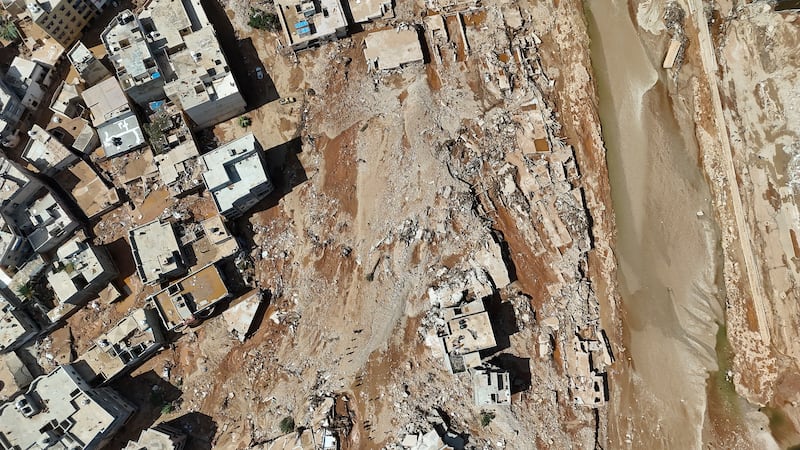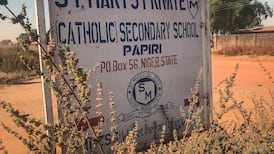Rescue workers were burying thousands of victims of floods in eastern Libya in mass graves as they struggled to cope with a disaster that has claimed thousands of lives and left many thousands more missing.
Anger was building among Libyans, many of whom expressed fury on social media after experts said that inadequate evacuation efforts ahead of the storm and a failure to maintain a crucial dam had led to the high death toll.
Officials expect the number of dead to continue rising as they battle to recover bodies in the coastal city of Derna, where the collapse of two dams worsened floods caused by a storm that struck the eastern Mediterranean region.
“They [the victims] are being buried in three mass graves. There’s no time or space to bury them in single graves,” said Osama Ali, a spokesman for the Ambulance and Emergency Center in Libya. “We removed 500 bodies in a single operation.”
READ MORE
Mr Ali said the confirmed death toll had risen to 5,500 and could increase, adding that an area of Derna measuring 10km by 10km had been “completely destroyed”. The Libyan Red Crescent put the death toll at about 11,000, but also said that was likely to rise.
Derna’s mayor, Abdulmenam Al-Ghaithi, told Saudi Arabia’s Arabiya TV on Wednesday that the death toll could reach as high as 20,000, based on the area of the city that was hit.
The city of 100,000 people was worst affected because of the collapse of the dams, which shone a spotlight on the dysfunction of Libya since dictator Muammer Gadafy was toppled in 2011 after a popular uprising that morphed into civil war.
In the run-up to the storm, many residents in Derna and the surrounding area were ordered to stay in their homes and evacuation efforts failed to come close to the scale of the impending disaster.
Petteri Taalas, head of the World Meteorological Organization, told reporters on Thursday that many casualties could have been avoided if Libya had a functioning weather service system. “If there would have been a normally operating meteorological service, they could have issued warnings,” he said.
“The emergency management authorities would have been able to carry out evacuation of the people. And we could have avoided most of the human casualties,” he added.
On Sunday morning as the storm began to hit Derna, the city’s security directorate called for the evacuation of homes near the sea and in a valley, while imposing a curfew in other areas. It posted pictures on Facebook of security patrols enforcing the instructions.
In a video posted on Sunday evening, Gen Mbarak Bouhara, head of the security directorate, called on residents to stay in their homes.
A report last year in a journal of Libya’s Sebha University warned about poor maintenance of the city’s main dam, calling for “immediate measures” to avoid “disastrous” consequences from a major flood.
Libya has been blighted by chaos and conflict for a decade, with rival administrations in the east and west. Infrastructure has been left to decay and government services are dire.
Yann Fridez, head of the International Committee of the Red Cross’s Libya delegation, said a seven-metre-high wave destroyed buildings and swept infrastructure into the sea. “Family members are missing, dead bodies are washing back up on shore and homes are destroyed,” he said. “The city faces immense emotional trauma.”

In interviews published on Facebook by a medical centre in the city of Benghazi, survivors recounted the horrors of the flood.
One man said that having heard a warning, he evacuated his family to another part of the city. When he asked some soldiers if that area was included in the warning zone, “they said no ... they forgot about the valley and the dam”, he said from a hospital bed.
Recalling the torrent of water, he said: “I heard a whoosh, I thought it was an aeroplane. The force of the water collapsed my neighbour’s house.”
Another survivor, Khalil Boushiha, said the flood swept him and his mother down the street until he grabbed a door and scrambled inside a house. He carried her to a higher floor as the water rose.
“The scene I saw afterwards... it’s impossible to describe,” he said. “Bodies were floating on the water, cars were floating by, girls were screaming. It lasted an hour or an hour and a half, but it felt like more than a year.”
The International Organization for Migration said this week that 30,000 people had been displaced in Derna, and several thousand more elsewhere.
Rescue workers have struggled to reach parts of Derna because roads have been washed away and electricity and communications cut. The eastern Libyan administration said more than 3,000 victims had been buried by Thursday morning, with a further 2,000 being processed, the Associated Press reported. – Copyright The Financial Times Limited 2023













